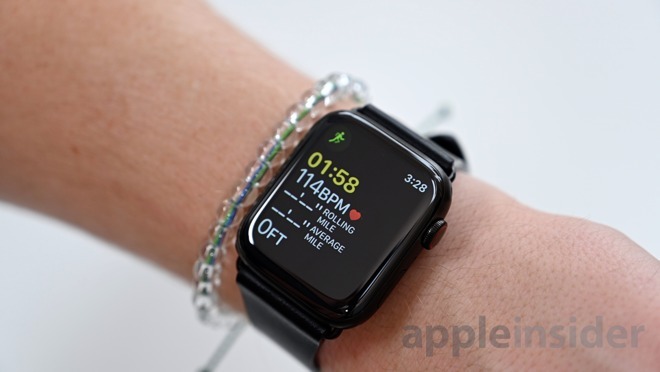Insurance provider John Hancock extended its Vitality life insurance program, which incentivizes healthy lifestyles by allowing customers to "earn" an Apple Watch, to include Apple Watch Series 5, the company said on Thursday.
New and existing policyholders will be able to purchase a new 40mm Apple Watch Series 5 for $25 this fall, John Hancock said in a press release. Customers can also opt for a 38mm Series 3 for the same price.
Like previous iterations of the Vitality Apple Watch program, customers can elect to outfit their watch with upgraded features like a larger screen or cellular connectivity for a one-time fee. The remainder of the purchase price is split into monthly payments spread over a two-year period, but policyholders can work off part or all of those dues by exercising regularly.
More specifically, customers earn Vitality Points when they log activity with Apple Watch. These points are converted into a monetary equivalent that goes toward monthly Apple Watch payments, which can be paid in full depending on a user's level of activity.
"Today's announcement further cements our commitment to motivate and inspire customers to both protect their financial futures and live longer, healthier lives," said Brooks Tingle, president and CEO of John Hancock Insurance. "The Apple Watch has been an extremely popular and effective component of our program as customers who use it report increased motivation and physical activity, the bottom line in what we're trying to do with our insurance."
Dubbed a "behavior change platform," John Hancock's Vitality launched in 2015 as an experiment in "interactive life insurance." The initiative grew to include Apple Watch Series 3 integration for policyholders in 2017, an option that rolled out to all life policies in 2018.
The trial appears to be working, as a recent in-house survey of John Hancock Vitality members showed 84% of respondents were motivated to exercise because of their Apple Watch, while 90% used the wearable seven days a week. John Hancock also cites a RAND Europe study of 400,000 people which found participants of Vitality's Global Apple Watch programs average a 34% sustained increase in physical activity over those who did not use the device.
 AppleInsider Staff
AppleInsider Staff







-m.jpg)






 Marko Zivkovic
Marko Zivkovic
 Christine McKee
Christine McKee
 Andrew Orr
Andrew Orr
 Andrew O'Hara
Andrew O'Hara
 William Gallagher
William Gallagher

 Mike Wuerthele
Mike Wuerthele
 Bon Adamson
Bon Adamson




-m.jpg)



2 Comments
This is great and very much needed -- but misguided on the part of John Hancock.
Healthy lifestyles are critical in reducing our $3.5Trillion / year of healtcare spending. But, since 80% of that goes to treat so called "age related" chronic diseases (which are mostly caused by unhealthy lifestyles rather than age) -- the biggest beneficiary of this program is likely to be Medicare rather than John Hancock. (And, of course, those participants who enable themselves to have healthy, fully functional old age)
But, regardless: Thank You John Hancock!
Vitality is not affiliated with John Hancock. Many employers offer Vitality along with their health insurance programs. The news from JH is that before, they had it as opt-in only and now, it is included in all of their insurance products. We have done it for about 7 years now. Participants in Vitality really do undergo changes in their lifestyle. They are subtle, but there is just enough incentive to make a difference. It has for my family and my company, where we have about 1,000 people actively participating. To give you an idea of the cost benefit to the employee, my wife and I get about 20,000 "Vitality Bucks" per year. To get the 20,000 points, we need to be fairly active, getting 5,000 or more steps in per day for at least 5 days a week and getting over 10,000 once in a while. We also do a biometric screening and do some training and questionnaires, which we can cash in on Amazon gift cards for $200. We must achieve "Gold" status in Vitality and do a couple of other things and our reward is a 15% discount on our insurance premiums, itself a nice chunk of change. We have used points to buy Fitbits in the past and it's good that one can now choose to buy an Apple Watch. Our company pays for Vitality and it is not a small amount. Furthermore, the premium discount is covered by the company, not by the insurance provider. Our company believes this is the right thing to do for the employees, and while we don't know if there is any true savings on our bottom line, there isn't talk yet that they will be discontinuing Vitality either. I hope not.